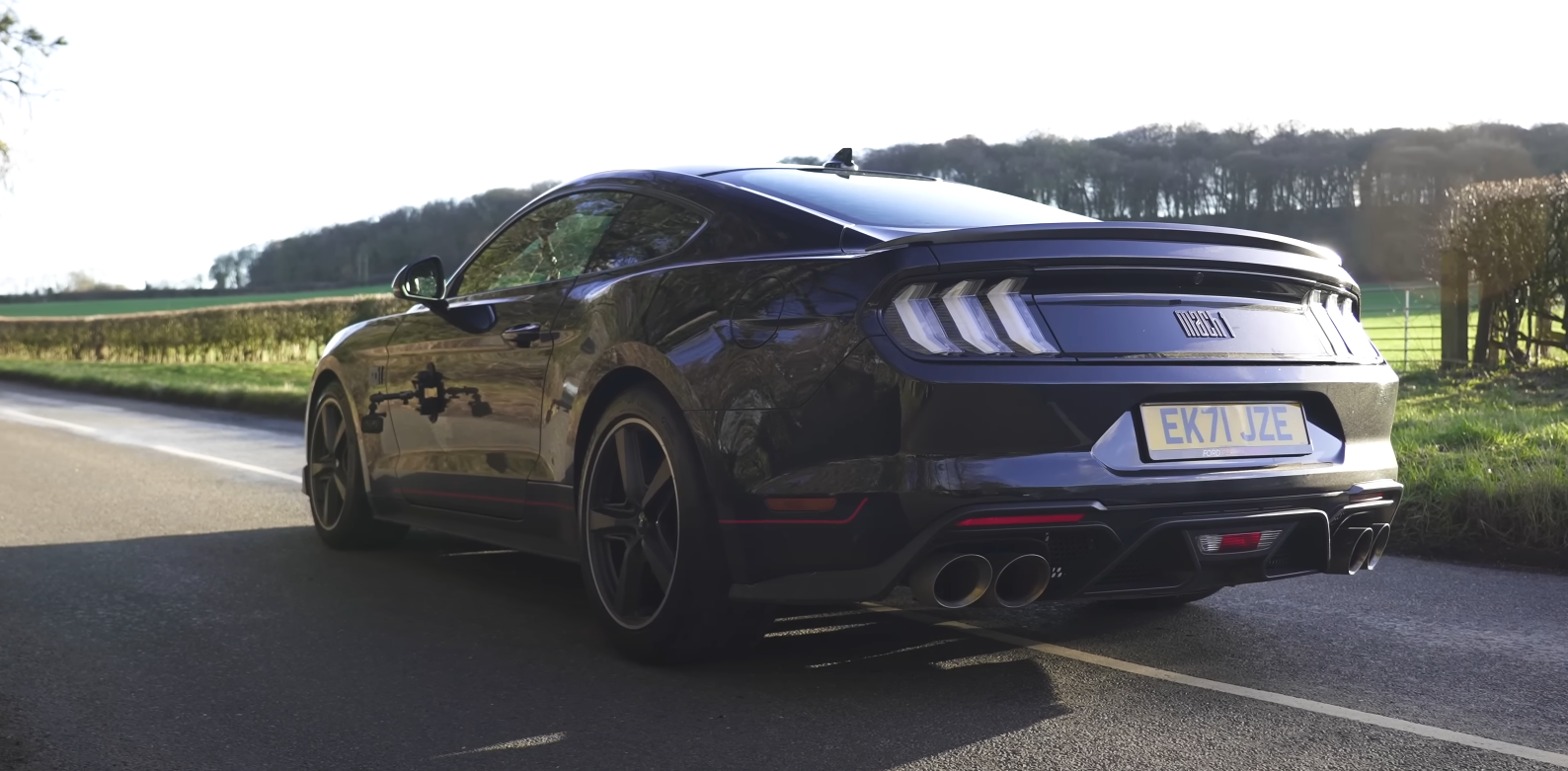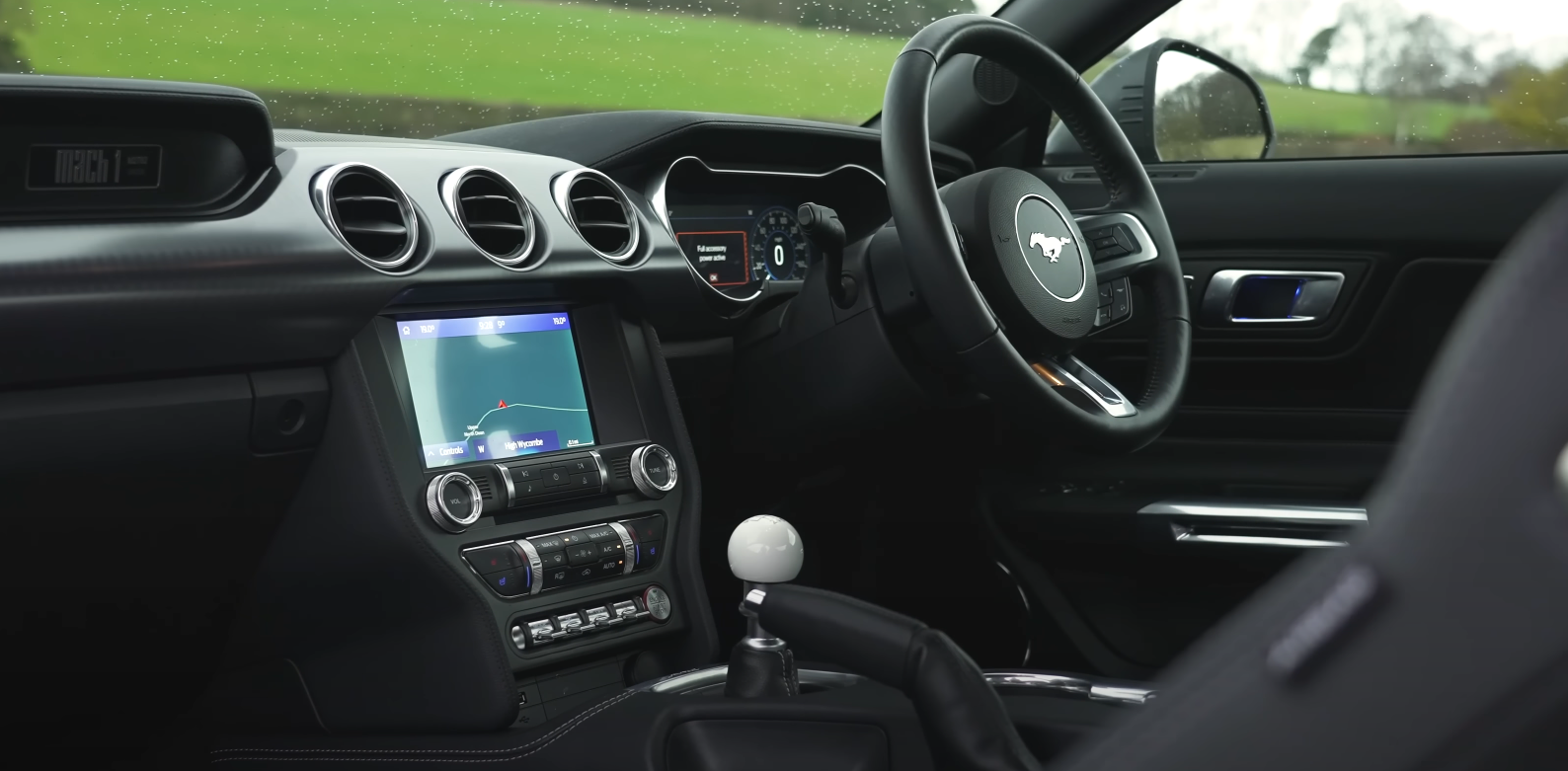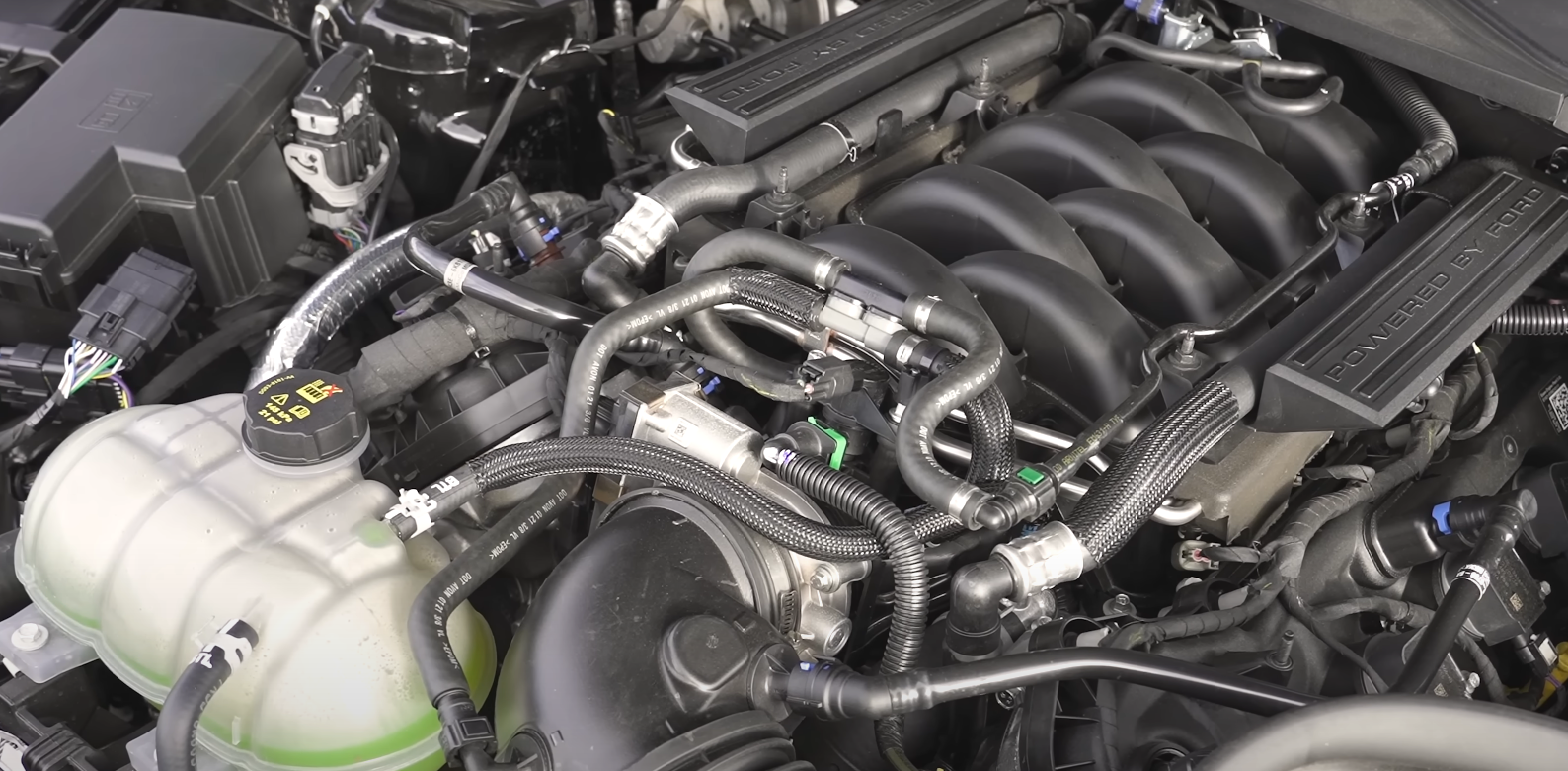The Ford Mustang remains one of the most recognizable sports cars on the road. Its design draws on classic styling cues while adding modern updates that make it stand out. The Mach 1 version builds on this with unique details such as larger exhausts, distinct badging, and aerodynamic changes that improve stability at higher speeds. It carries the familiar long bonnet and coupe shape, keeping the traditional Mustang look while offering a few performance-focused upgrades.
Inside, the layout is straightforward and easy to use, with digital displays and smartphone connectivity included as standard. The Mach 1 adds special trim and a unique gear knob to set it apart. While the interior quality is functional rather than luxurious, it offers a sporty driving position and practical features like a manual handbrake and multiple storage areas. Rear seats are tight for adults, but the boot provides useful space, even if access is limited.
Key Takeaways
- The design blends classic styling with performance-focused updates
- The interior is simple, functional, and includes modern tech
- Space is usable, though rear seating and boot access are limited
Exterior Design
Traditional Mustang Look
The Mustang keeps its well-known two-door coupe shape with a long hood and the familiar pony badge on the grille. The rear lights carry a design that recalls earlier models, giving it a strong link to its past. Side skirts and bold body lines add to the classic muscle car stance.
Mach 1 Distinctive Elements
The Mach 1 version replaces the standard GT badge with a Mach 1 emblem and adds a small rear spoiler and diffuser. It comes with larger quad exhaust tips that are fully functional. The hood features a matte-effect stripe and real vents, while the front gains a deeper splitter to improve stability at speed.
Wheels and Emblems
- 19-inch alloy wheels come standard.
- Mach 1 offers its own wheel designs, with the option to upgrade to Forged alloy wheels.
- The side carries a stripe with the Mach 1 name instead of the usual 5.0 badge.
A table helps show the key differences:
| Feature | Standard Mustang | Mach 1 |
|---|---|---|
| Rear Badge | GT | Mach 1 |
| Exhaust Tips | Quad, standard | Quad, larger |
| Hood Design | Plain | Matte stripe + vents |
| Wheels | 19-inch alloys | Unique designs, optional forged |
| Front Splitter | Standard | Extended splitter |
Aerodynamic Changes
The Mach 1 includes changes aimed at reducing lift at higher speeds. The front splitter, rear diffuser, and boot lip spoiler all play a role in keeping the car more planted. While some side vents are only cosmetic, the functional elements give the car better balance and stability compared to the standard model.
Cabin Details
Dashboard and Finishes
The dashboard design feels simple and easy to use, with a retro touch that links back to earlier models. The Mach 1 version adds unique trim pieces, special badging, and a distinct gear knob. Overall quality is fine, though it does not match premium rivals like BMW or Porsche.
Media and Smartphone Links
A central screen comes standard, supporting Apple CarPlay and Android Auto. Built-in navigation is not included, but most drivers will find smartphone integration more than enough. The system works reasonably well, though it is not the quickest or smoothest on the market.
Digital Gauge Cluster
The car features a large digital display for the driver. The look of the dials changes depending on the selected drive mode. While the graphics are clear, the rev counter in race mode is less intuitive and may feel awkward to use.
Seats and Driving Setup
The driving position offers good adjustment through the steering wheel, and the seat provides decent comfort. However, the seat could sit lower for a sportier feel. Ventilated seats are standard, but choosing the optional Recaro seats removes that cooling function.
Traditional Handbrake
Unlike many modern cars that use electronic parking brakes, this model keeps a manual handbrake. It is practical for everyday use and makes handbrake turns possible, which driving enthusiasts may appreciate.
Practical Use and Storage
Front Cabin Spaces
The cabin offers a few handy storage spots. There’s a small compartment in the center with USB and 12V ports, a glovebox that’s modest in size, and an extra shallow tray that works for coins or small items. Cup holders sit in the middle, but their placement can get in the way when reaching for the gear knob.
Storage highlights:
- Manual handbrake next to the console
- Two USB ports and two 12V sockets
- Narrow door bins that struggle with larger bottles
Back Seat Functionality
Accessing the rear seats requires pulling a lever, but the seat doesn’t slide forward on its own, which makes climbing in awkward. Once inside, knee space is tight and foot room feels cramped. Headroom is limited, with taller passengers brushing against the rear glass.
- Short trips are possible, but not comfortable
- ISOFIX points are present, though buried deep
- Rear seats can fold down to allow longer items through
Trunk Size and Opening
The boot measures 408 liters, which is generous for a coupe. The issue is not the size but the shape of the opening. The narrow aperture and raised lip make it harder to load bulky items.
| Feature | Detail |
|---|---|
| Capacity | 408 liters |
| Access | Narrow opening |
| Loading lip | Noticeable step |
While the space itself is useful, the design means it works best for smaller luggage rather than wide or heavy gear.
Performance and Driving Feel
Powertrain and Exhaust Note
The Mustang uses a V8 engine that delivers a strong and classic muscle car sound. Unlike many European rivals, it does not have a soft limiter, so the driver can rev it freely even when stationary. The Mach 1 version includes larger quad tailpipes, which are fully functional and add to the deeper exhaust tone. A Quiet Start feature is available, allowing the car to start with reduced noise for early mornings or residential areas.
Drive Settings
The car offers multiple selectable modes that adjust the digital driver display and the driving response. Each mode changes the look of the dials, with the Race mode featuring a unique rev counter design. The toggle-style switch for changing modes only moves in one direction, so if the driver skips past the desired setting, they must cycle through again.
Speed and Launch Control
The Mustang can be launched from a standstill to 60 mph using its powerful V8. The Mach 1 model is designed for stronger track performance, though it actually weighs slightly more than the standard version by about 8 kg. Despite the added weight, the car still delivers quick acceleration and an engaging launch experience.
Steering and Ride Comfort
The steering wheel feels sporty and offers enough adjustment to find a comfortable position. The car’s suspension and chassis balance provide a mix of control and comfort. However, the seating position could sit lower for a more performance-focused feel. At higher speeds, the aerodynamic changes on the Mach 1 help reduce lift, improving stability.
Equipment and Technology
Core and Extra Options
The Mustang includes a mix of equipment that blends classic style with modern updates. A digital driver’s display changes its look depending on the driving mode, while the infotainment system supports Apple CarPlay and Android Auto as standard. Built-in navigation is not included by default.
The Mach 1 trim adds details like a unique gear knob, special dashboard trim, and badging. Ventilated seats come standard, but choosing the optional Recaro seats removes that feature. Storage is practical enough, with USB ports, 12-volt sockets, and a few small compartments, though some spaces are limited in size.
| Feature | Standard Mustang | Mach 1 Version |
|---|---|---|
| Alloy Wheels | 19-inch | Unique designs, optional larger wheels |
| Exhaust | Quad pipes | Larger real quad pipes |
| Seats | Ventilated | Ventilated (lost if Recaro chosen) |
| Cruise Control | Adaptive | Basic system only |
Driver Aids and Support Tools
The Mustang offers several helpful systems, though availability changes by trim. The regular model includes adaptive cruise control, but the Mach 1 only has a simpler version. Driving modes can be switched through toggle-style buttons, though they only move in one direction, which can be less convenient when cycling past the desired setting.
The car also features adjustable exhaust modes, including a quiet start option that reduces noise during ignition. This allows the driver to control how loud or subtle the car sounds, depending on the situation.
Pros and Cons
Key Strengths
- Authentic styling: Classic Mustang design cues remain, with real quad exhaust pipes, a long hood, and unique Mach 1 details like stripes, spoilers, and a front splitter.
- Engine sound: The V8 delivers a raw exhaust note without soft limiters, and drivers can choose between loud, quiet, or even “quiet start” modes.
- Interior touches: Mach 1 adds special trim, badges, and a unique gear knob. The digital driver display changes with driving modes, and the manual handbrake appeals to enthusiasts.
- Practicality for a coupe: The boot offers 408 liters of space, and folding rear seats allow longer items to fit through.
- Standard features: Ventilated seats, Apple CarPlay, Android Auto, and multiple USB and 12V ports come included.
| Feature | Benefit |
|---|---|
| Exhaust system | Adjustable sound modes |
| Boot space | 408 liters, foldable seats |
| Infotainment | Apple CarPlay & Android Auto |
| Seating | Ventilated seats (non-Recaro) |
| Design | Classic Mustang look with Mach 1 extras |
Noted Limitations
- Interior quality: Materials feel fine but not at the level of premium rivals like BMW or Porsche.
- Rear seating: Limited headroom and foot space make the back seats uncomfortable for adults.
- Practicality issues: The boot opening is narrow with a lip, making it harder to load larger items.
- Feature trade-offs: Upgrading to Recaro seats removes seat ventilation, and Mach 1 loses adaptive cruise control found in the standard model.
- Weight: At 1,843 kg, the car is heavy for a sports coupe, and the Mach 1 is slightly heavier than the standard version.
- Controls: Toggle-style switches only move upward, making it awkward to cycle through drive modes.
- Storage: Narrow door bins force larger bottles into cup holders, which block access to the gear knob.
| Drawback | Impact |
|---|---|
| Rear seats | Cramped for adults |
| Cruise control | Basic system on Mach 1 |
| Boot access | Narrow opening with lip |
| Weight | 1,843 kg, heavier than expected |
| Seat options | Recaros remove ventilation |
Pricing and Value
Entry-Level Cost
The Mustang begins at £48,000, making it one of the more accessible V8-powered coupes on the market. At this price, buyers get a well-equipped car with features such as a digital driver’s display, smartphone connectivity, and a strong performance setup as standard.
| Model | Starting Price |
|---|---|
| Mustang (Base) | £48,000 |
Ways to Save Money
Through Carwow, buyers can often reduce the purchase price by an average of £1,500. In addition to discounts on new cars, the platform allows owners to sell their current vehicle by uploading photos and details, after which dealers place bids. This process helps ensure competitive offers without the need for private negotiations.
Key benefits include:
- Average savings of £1,500 on a new Mustang
- Dealer bidding system for selling used cars
- Simple process with online tools for quick results







